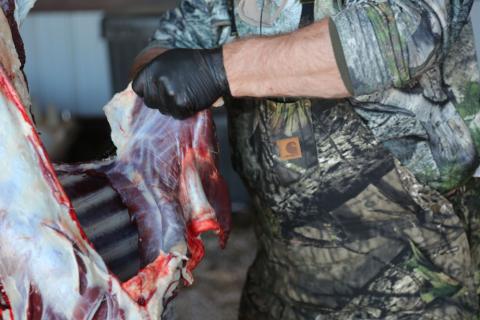Todd Amenrud | Originally published in GameKeepers: Farming for Wildlife Magazine. To subscribe, click here.
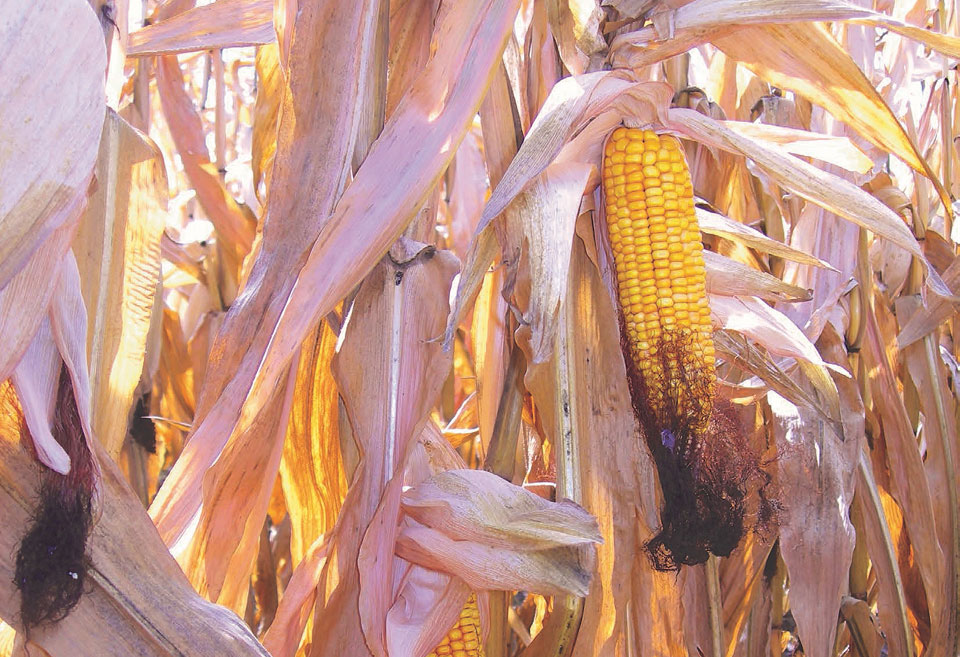
Some managers believe there are two things you need if you wish to plant corn on your property – adequate acreage and a corn planter or drill. Oh contraire monfrère ... although you will need enough acreage to keep up with the amount of pressure your animals are putting on it, you don’t necessarily need a corn planter or drill. Corn can simply be broadcasted! Oh Todd, tell us more!
So let’s begin by talking about the “density to acreage” issue to get it out of the way so we can talk about “how to plant it.” You will need enough acreage in corn to keep up with the amount of deer, turkeys and other animals feeding on it. This magical number will vary depending upon many factors - your location north to south, quality and amount of native foods, how much total acreage you’re putting into corn, whether or not there is cash-crop corn farming nearby, etc. A one-acre plot of corn throughout most of the USA or Canada will be ripped out by the roots before it ever has a chance to tassel. You’ll just have to estimate and give it a shot. Success with corn can be had with plots as small as two acres in areas with low density or where you have cash-crop farming to back you up. However, in areas of high density two acres will probably not be enough. I would suggest that you plant at least four to six total acres in spots where corn farming is prevalent and there to back you up, and at least 10 to 12 acres in spots where there is no corn in the area.
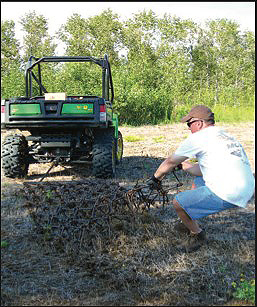
producing a good stand of corn by
broadcasting is to find a way to cover
the seed the appropriate depth.
Harrow drags like these can be
purchased in 4’x6’ sections. A disk or
other types of drags may also work.
OK, you’ve got the acreage, but no corn planter. Worry not. Corn can be broadcasted. In fact, other larger seeds can also be broadcasted. Where normally I like to prepare my seedbed well in advance of planting and prefer a firm, weed-less, flat seedbed, when broadcasting larger seeds like corn, beans or peas I prefer a somewhat fluffier bed. This way the soil covers the seeds easier. I can manipulate the soil easier if it’s just been worked. In fact, because most often I will be using a Roundup Ready variety of corn, I sometimes won’t initially burn-down the spot first, since I’ll be coming back about 30 days later to apply glyphosate anyhow.
The key to this whole deal is finding a way to bury the correct amount of seeds the appropriate depth. Any type of broadcaster will do as long as it will spread the seeds for you. Since not every seed will be buried at a uniform depth like it would be with a metered corn planter or drill, from my experience you want to increase your seed rate approximately 15%. Some seeds will be a little deep and some seeds will be a little shallow, but you want the better majority to be in an acceptable germination zone.
Possibly the most important detail is finding an implement that will cover the seeds the appropriate depth with your particular soil type and your specific way of preparing the seed bed. I’ve had success with certain cultipackers, disks, drags and harrows.
The rule of thumb when using a disk is to set it at twice the depth you want the seeds planted. So if you have a 1-inch planting depth, set the disk at 2 inches, an inch and a half planting depth, set the disk at 3 inches. Again, not every seed will be perfect, but by increasing your seeding rate 15%, the better majority should be in the “germ zone.” You may have to do some trial and error with your method to fine-tune it, but I broadcast-plant corn all the time with success.
You really can’t beat the look or yield of a plot done with the proper equipment, and I do use a corn planter from time to time and a drill for planting beans, but as an absentee landowner or doing work on other people’s properties, you simply can’t trailer everything you need...including a corn planter.
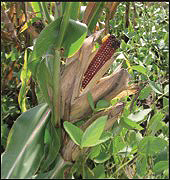
corn & soybeans can be
blended together. Isn’t it
remarkable that a
whitetail can remove
every kernel without
knocking the cob off the
stalk?
My brother-in-law, Mike Berggren, and I plant our corn and soybeans on our Ontario property this way every year. Being absentee landowners, we can only haul so many vehicles and implements each time we go. I normally store my equipment at my home in Minnesota so we need to broadcast our corn in Ontario each spring.
I’ve tried covering the corn seed with a disk, but my preferred method is to use a harrow. Or what I refer to as a harrow – an implement consisting of a heavy frame with sharp tines or teeth. I’ve heard it called a “drag” or a “harrow- drag” also, but they’re typically sold in 4-foot by 6-foot sections. The tines are usually about 8 inches long and angled one way so it can be used in three different ways – aggressive with the teeth angling forward, medium aggressive with the teeth angled back, or completely flipped over so the teeth aren’t engaged at all (so it can be used for planting smaller seeds like clovers and brassicas too).
BioLogic had a blend several years ago called BioMaxx. It was a great blend, but the logistics of working with a huge company like Monsanto just wasn’t working out. We would have had to sell the product at more than we believed our customers could bear and still wouldn’t make any profit, so we simply discontinued it. Regardless, it was a great blend. It featured 3 varieties of Roundup Ready soybeans (with different characteristics) and two varieties of Roundup Ready corn (one early producer and one huge yield, both very attractive to whitetails).
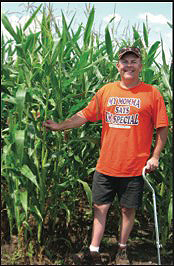
not necessary to produce
a productive corn plot for
your wildlife. Here, the
author is posing with a
corn plot that was
broadcasted on his
Ontario property.
I still do this corn/soybean fusion from time to time but not as often as I used to simply because I like to “double-crop” a lot of my beans. Once your soybean leaves turn brown they fall off allowing the sunlight to hit the soil. It will depend on the varieties of beans you have also. Some of these new “mutant” varieties of beans being engineered specifically for whitetails are unreal, they’ll grow chest to shoulder-high! But if you have normal knee-high beans, you can often get away with broadcasting brassicas, beats, clovers or small cereals right amongst your beans and just go over it with a cultipacker. After all, you have a weed-free seedbed sitting underneath those Roundup Ready beans that you’ve been spraying with glyphosate during the summer, why not use it? Brassicas especially work great to seed in amongst the beans. They love the nitrogen the beans have been affixing to the soil.
If you are mixing beans and corn I’ve messed around with recipes over the years and for an easy no fuss, no mess wildlife plot mixing them together does work well. The beans affix good nitrogen so you get beautiful green corn that cobs-out well. I’ve used ratios of anywhere from about 10% to 20% corn with the rest soybeans. It really depends upon the varieties you choose, but right about in the middle at around 15% corn seems to work well.
If you choose to plant your corn separately, as I most often do, simply go by the instructions for that specific variety and increase the rate by about 15% from the normal drilled rate. Again, one of the most important details is finding a way to cover your seeds the appropriate depth and there are a good number of acceptable ways to get it done.
Planting corn is not out of reach for absentee landowners or managers on a budget or who don’t have big equipment. And while corn often gets put to the side in some management plans because it doesn’t yield as much when compared to other crops, it does have a place in a food plot plan if you have the acreage to devote. Corn can be a critical part of a wintertime nutrition program, it can help bucks recoup from the rut, it supplies needed energy to many other game birds, big game and waterfowl and in the north it provides an obtainable food source when everything else is covered with snow.

















